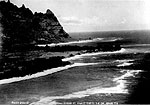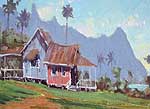 |
|
Old Halele'a
As the "historical" period unfolded, several noted travelers came to
Hā‘ena and wrote accounts of their visits, especially to the
famous caves. Some of these records are presented here. Their writings
demonstrate
changing perceptions of landscape features, both from the Hawaiian
context and across different historical periods. |
 |
 |
|
Horse & Cattle Days
From the late 18th to the early 19th century, during the days of the
Hui Ku‘ai ‘Aina, cattle ranching was the predominant economy
at Hā‘ena, and horses the major mode of transportation. Samson
reflects on those days, and on riding the Kalalau trail. |
 |
 |
|
Partition
One of the notable features of Hā‘ena after the mahele is the
creation of this land-owning collective. Carlos tells us more about
it, and the events that led to its demise in the 1950s.
|
 |
 |
|
Tsunamis
Two major tsunamis hit the Hawaiian Islands and Hā‘ena in particular,
one in 1946 and one in 1957. This section presents newspaper records
from the time, discussing the extent of the damage and the episodes
of heroism that took place. |
 |
 |
|
Taylor Camp
In the 1960s, a "hippie" community came into being on the shore at
Hā‘ena.
Located on land purchased by Elizabeth Taylor's brother, "Taylor Camp"
became a renowned location for young, mostly non-Hawaiians looking
to drop out of mainstream American society. An excellent article on
the history and geography of this community is reproduced here from
the Field Museum of Natural History Bulletin. |
 |





































